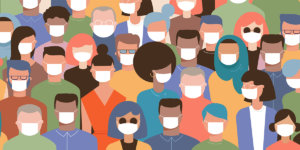
The COVID Computational Challenge sought to create a solution to the challenge of determining the risk of exposure to COVID-19 at a wide range of locations in the City of Los Angeles, from shopping malls to office buildings to restaurants. Image Credit: Gerd Altmann
A team of researchers at the USC Viterbi School of Engineering recently won first place in the 2020 COVID-19 Computational Challenge for a new metric to evaluate the risk of exposure for COVID-19. The competition called for a solution to the challenge of determining the risk of exposure to COVID-19 in city of Los Angeles.
The competition — hosted by the city of Los Angeles and RMDS Lab, a Pasadena-based non-profit that works with 35,000 data science professionals — also saw second place entries from Rensselaer Polytechnic Institute and Zhejiang University.
“We are delighted to receive first place and more than happy to learn that our work benefits our local community,” said Gowri Ramachandran, a senior research associate in the Ming Hsieh Department of Electrical and Computer Engineering, who was one of the four researchers who contributed to the winning submission.
Ramachandran worked alongside lead researcher, Bhaskar Krishnamachari, a USC Viterbi professor in electrical and computer engineering and computer science; Mehrdad Kiamari, a Ph.D. student studying electrical engineering; and Quyn Nguyen, a USC research programmer, to develop the solution.
Their winning metric summarizes the probability of an individual getting infected by COVID-19 in the near future with a number called a “risk score.” This risk score represents the number of individuals per 10,000 estimated to become infected with COVID-19 in the next 24 hours.
“For example, if the risk score is 3 in a community today, then an individual statistically has a 3 in 10,000 chance of becoming infected this day in that community,” said Krishnamachari, a Ming Hsieh Faculty Fellow in Electrical Engineering-Systems.
The risk score in a certain community is estimated based on two factors: the number of people currently infected and the average number of people that each currently infectious person will infect on a given day.
“The ultimate goal is to provide a useful data-driven tool for the city of Los Angeles, so they can assess the spread of COVID-19 and inform the public of their risk of infection on an ongoing basis,” Kiamari said.
Krishnamachari and his team wanted their metric to be easy for the general public to understand, so they also created a way to convey the risk of infection visually: by corresponding the numerical risk score to a color. For example, the color green corresponds to very low risk, while the color red corresponds to high risk. This qualitative metric can be used to color-code a map of Los Angeles to show which communities are at what level of risk. The city of Los Angeles has expressed interest in adopting such a community-level color-coded risk notification model.
“We believe this work will be broadly beneficial to citizens in communities worldwide by making it easier and more intuitive and tangible to understand and track their own individual level of risk when going about their activities in the community,” Krishnamachari said. “The risk score could also inform the effort of government agencies in terms of what level of shutdown or stay-at-home measures are required, or help them direct scarce resources in terms of testing, contact tracing to the communities that are most in need.”
Although the metric is currently only modeling data in Los Angeles, Krishnamachari is hopeful that in the future, their risk estimation approach can be used in other communities around the world.
Published on August 26th, 2020
Last updated on June 14th, 2023










